light TOYOTA PRIUS 2018 (in English) User Guide
[x] Cancel search | Manufacturer: TOYOTA, Model Year: 2018, Model line: PRIUS, Model: TOYOTA PRIUS 2018Pages: 820, PDF Size: 15.63 MB
Page 20 of 820
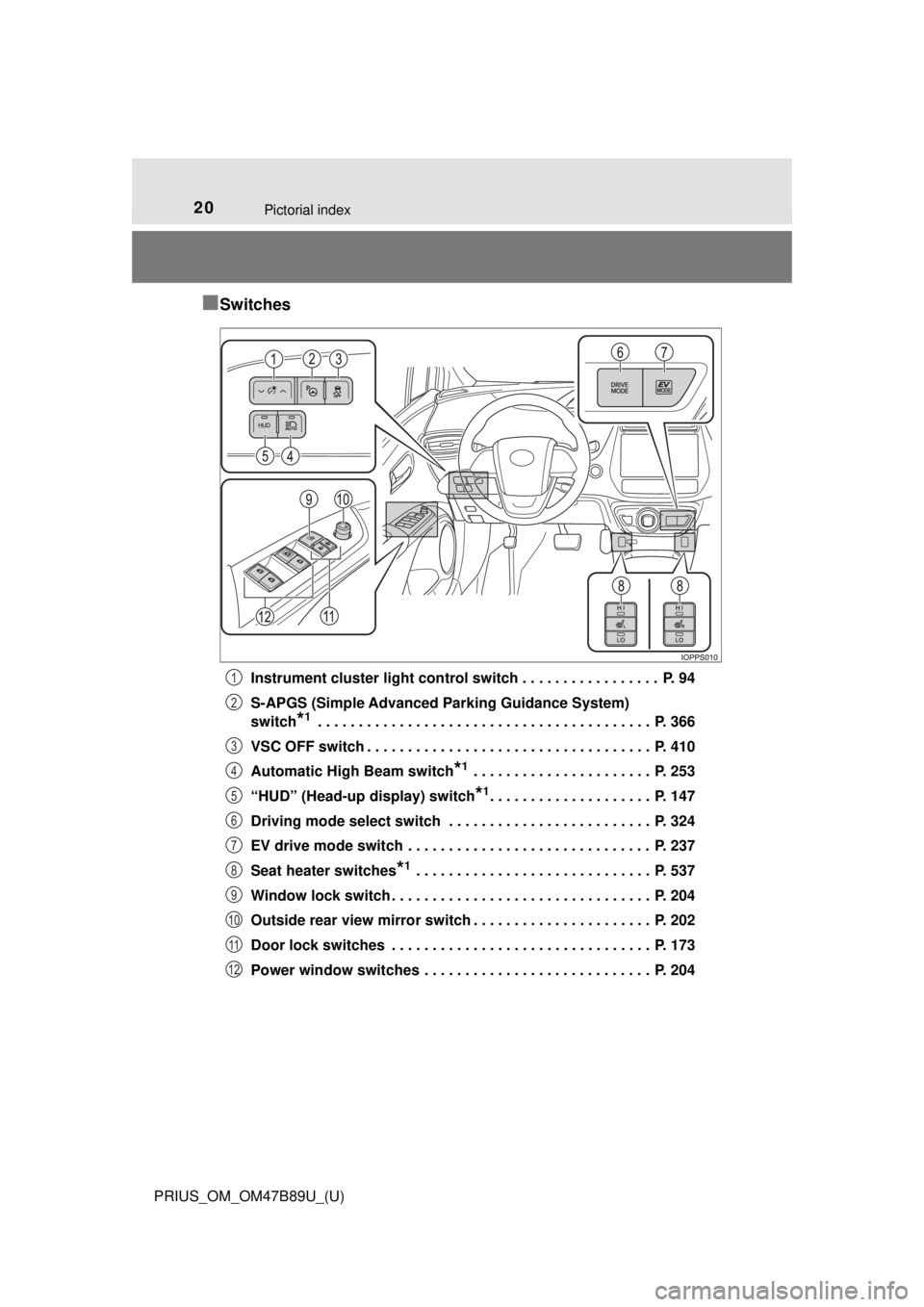
20Pictorial index
PRIUS_OM_OM47B89U_(U)
■Switches
Instrument cluster light control switch . . . . . . . . . . . . . . . . . P. 94
S-APGS (Simple Advanced Parking Guidance System)
switch
*1 . . . . . . . . . . . . . . . . . . . . . . . . . . . . . . . . . . . . . . . . . P. 366
VSC OFF switch . . . . . . . . . . . . . . . . . . . . . . . . . . . . . . . . . . . P. 410
Automatic High Beam switch
*1 . . . . . . . . . . . . . . . . . . . . . . P. 253
“HUD” (Head-up display) switch
*1. . . . . . . . . . . . . . . . . . . . P. 147
Driving mode select switch . . . . . . . . . . . . . . . . . . . . . . . . . P. 324
EV drive mode switch . . . . . . . . . . . . . . . . . . . . . . . . . . . . . . P. 237
Seat heater switches
*1 . . . . . . . . . . . . . . . . . . . . . . . . . . . . . P. 537
Window lock switch . . . . . . . . . . . . . . . . . . . . . . . . . . . . . . . . P. 204
Outside rear view mirror switch . . . . . . . . . . . . . . . . . . . . . . P. 202
Door lock switches . . . . . . . . . . . . . . . . . . . . . . . . . . . . . . . . P. 173
Power window switches . . . . . . . . . . . . . . . . . . . . . . . . . . . . P. 204
1
2
3
4
5
6
7
8
9
10
11
12
Page 23 of 820
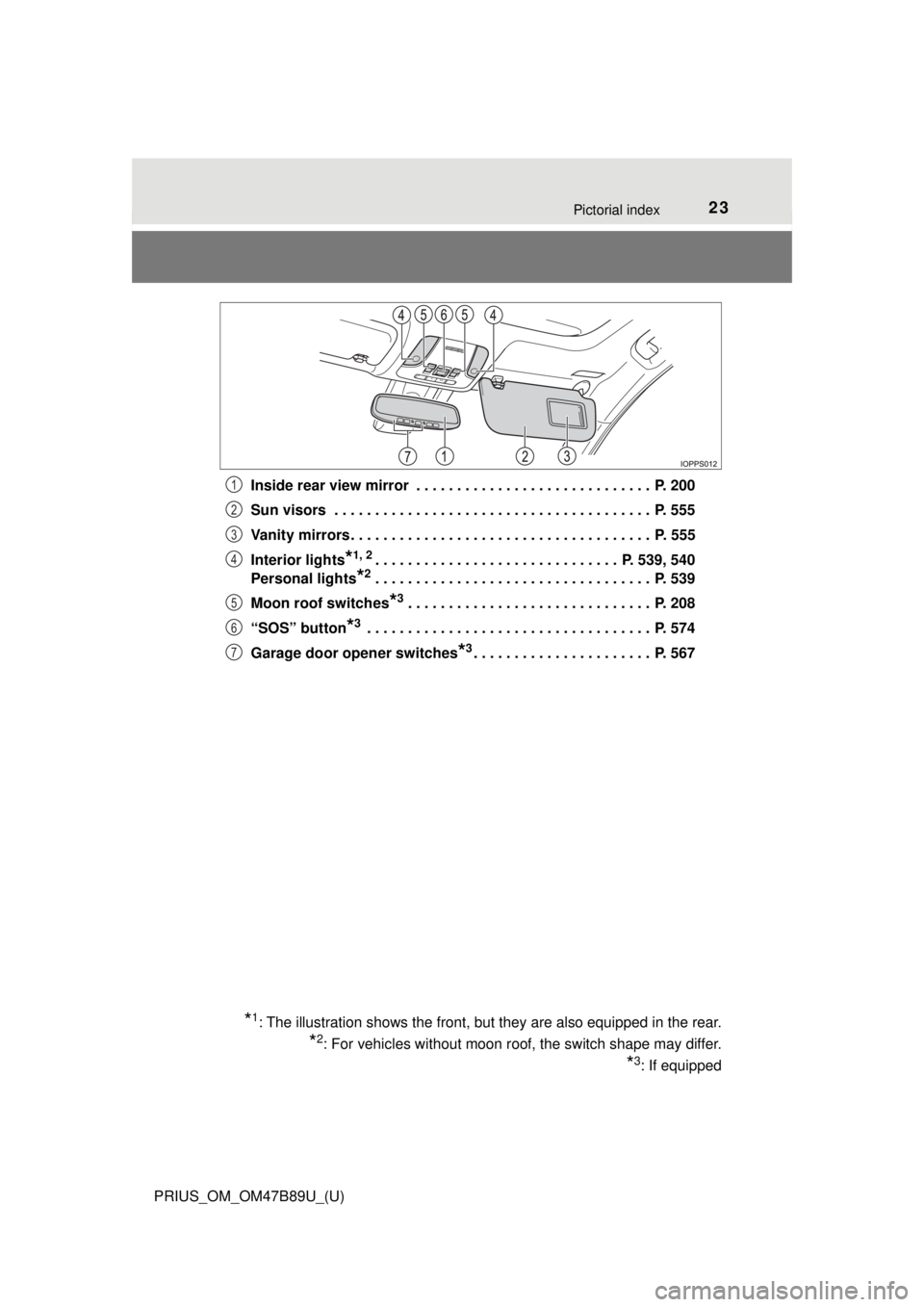
23Pictorial index
PRIUS_OM_OM47B89U_(U)Inside rear view mirror . . . . . . . . . . . . . . . . . . . . . . . . . . . . . P. 200
Sun visors . . . . . . . . . . . . . . . . . . . . . . . . . . . . . . . . . . . . . . . P. 555
Vanity mirrors . . . . . . . . . . . . . . . . . . . . . . . . . . . . . . . . . . . . . P. 555
Interior lights
*1, 2. . . . . . . . . . . . . . . . . . . . . . . . . . . . . . P. 539, 540
Personal lights
*2 . . . . . . . . . . . . . . . . . . . . . . . . . . . . . . . . . . P. 539
Moon roof switches
*3 . . . . . . . . . . . . . . . . . . . . . . . . . . . . . . P. 208
“SOS” button
*3 . . . . . . . . . . . . . . . . . . . . . . . . . . . . . . . . . . . P. 574
Garage door opener switches
*3. . . . . . . . . . . . . . . . . . . . . . P. 567
*1: The illustration shows the front, but they are also equipped in the rear.
*2: For vehicles without moon roof, the switch shape may differ.
*3: If equipped
1
2
3
4
5
6
7
Page 28 of 820
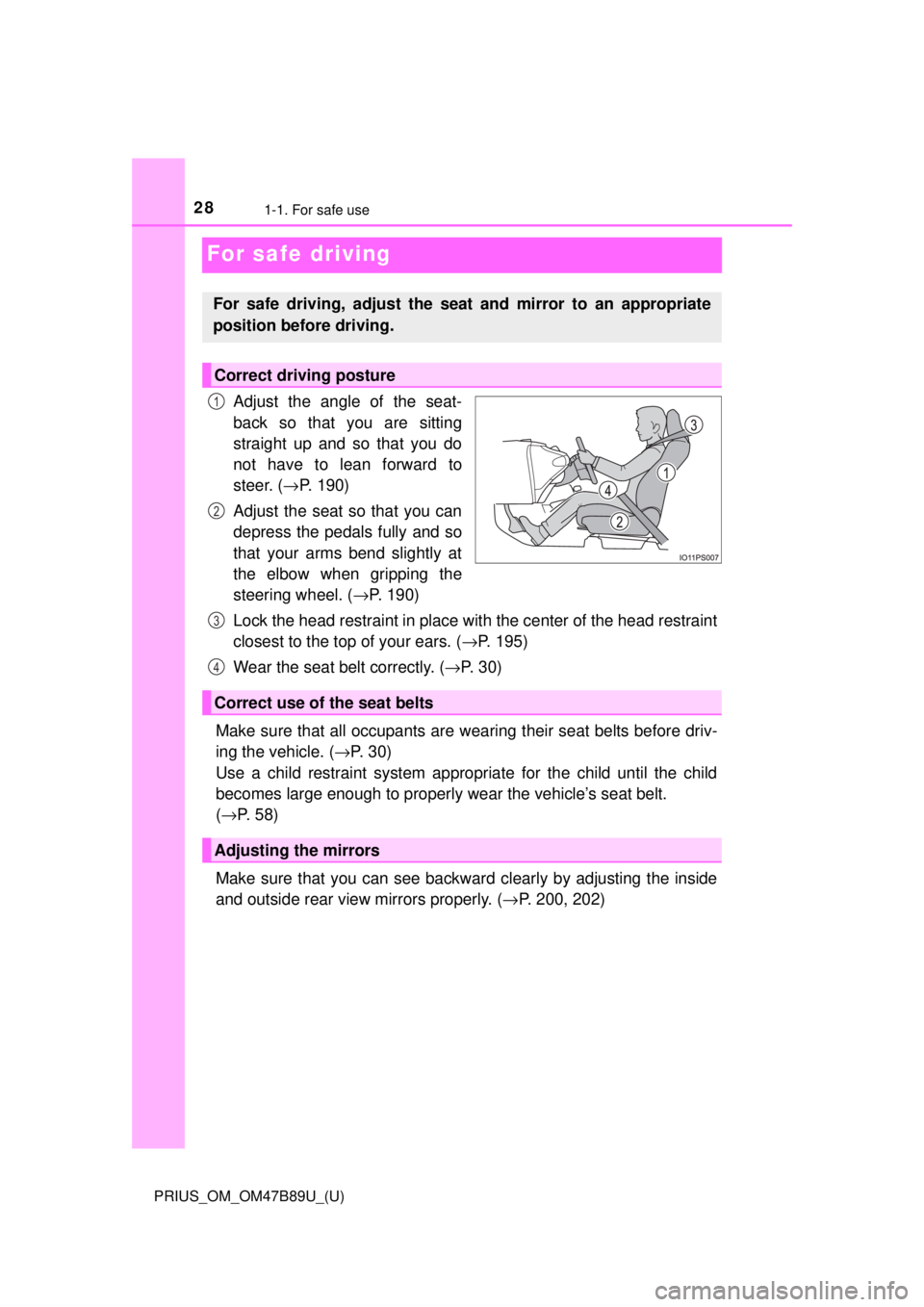
281-1. For safe use
PRIUS_OM_OM47B89U_(U)
For safe driving
Adjust the angle of the seat-
back so that you are sitting
straight up and so that you do
not have to lean forward to
steer. (→P. 190)
Adjust the seat so that you can
depress the pedals fully and so
that your arms bend slightly at
the elbow when gripping the
steering wheel. ( →P. 190)
Lock the head restraint in place with the center of the head restraint
closest to the top of your ears. ( →P. 195)
Wear the seat belt correctly. ( →P. 3 0 )
Make sure that all occupants are we aring their seat belts before driv-
ing the vehicle. ( →P. 3 0 )
Use a child restraint system appropriate for the child until the child
becomes large enough to properly wear the vehicle’s seat belt.
( → P. 58)
Make sure that you can see backwar d clearly by adjusting the inside
and outside rear view mirrors properly. ( →P. 200, 202)
For safe driving, adjust the seat and mirror to an appropriate
position before driving.
Correct driving posture
1
2
Correct use of the seat belts
Adjusting the mirrors
3
4
Page 31 of 820
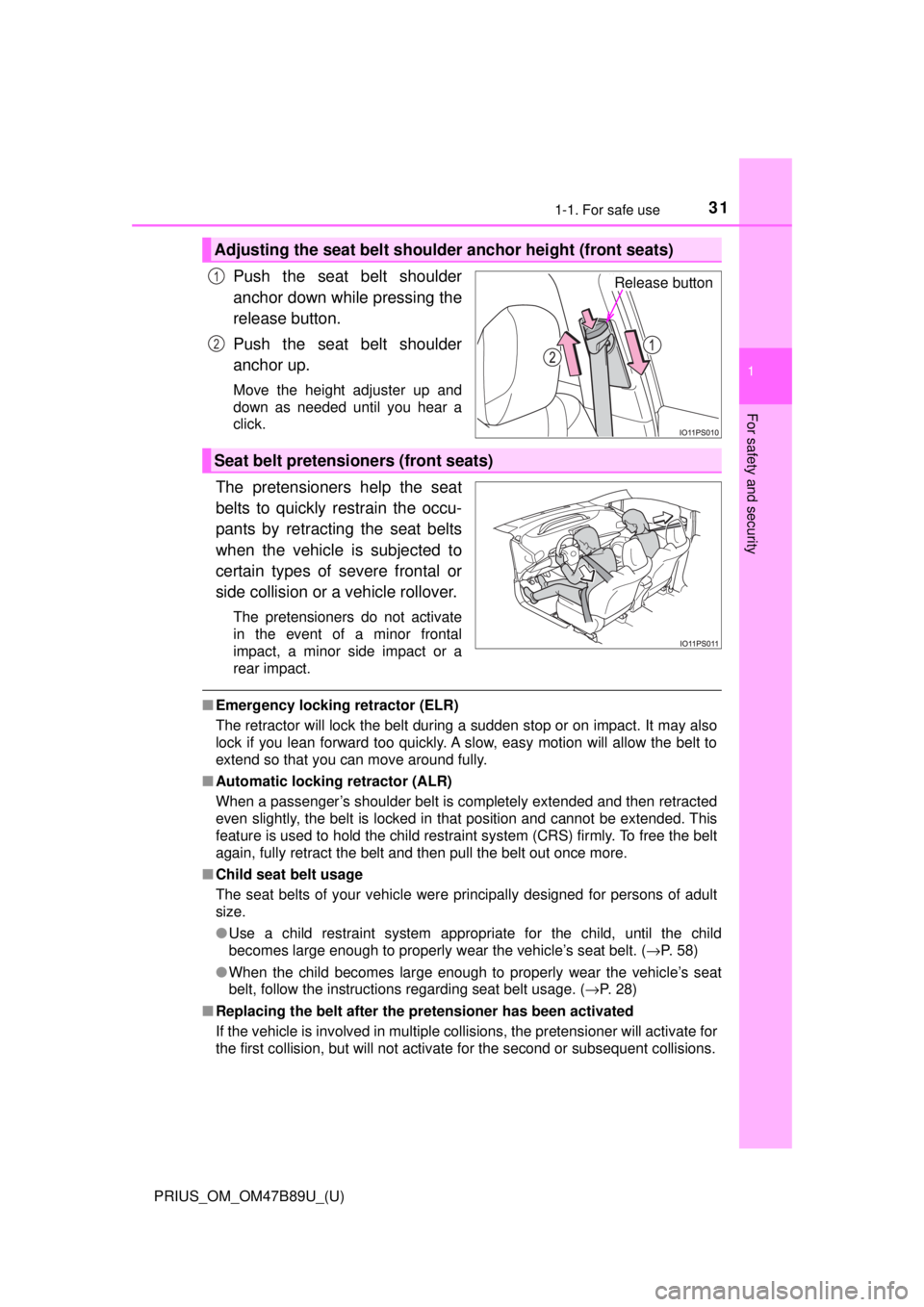
311-1. For safe use
PRIUS_OM_OM47B89U_(U)
1
For safety and security
Push the seat belt shoulder
anchor down while pressing the
release button.
Push the seat belt shoulder
anchor up.
Move the height adjuster up and
down as needed until you hear a
click.
The pretensioners help the seat
belts to quickly restrain the occu-
pants by retracting the seat belts
when the vehicle is subjected to
certain types of severe frontal or
side collision or a vehicle rollover.
The pretensioners do not activate
in the event of a minor frontal
impact, a minor side impact or a
rear impact.
■Emergency locking retractor (ELR)
The retractor will lock the belt during a sudden stop or on impact. It may also
lock if you lean forward too quickly. A slow, easy motion will allow the belt to
extend so that you can move around fully.
■ Automatic locking retractor (ALR)
When a passenger’s shoulder belt is completely extended and then retracted
even slightly, the belt is locked in that position and cannot be extended. This
feature is used to hold the child restraint system (CRS) firmly. To free the belt
again, fully retract the belt and then pull the belt out once more.
■ Child seat belt usage
The seat belts of your vehicle were principally designed for persons of adult
size.
●Use a child restraint system appropriate for the child, until the child
becomes large enough to properly wear the vehicle’s seat belt. ( →P. 58)
● When the child becomes large enough to properly wear the vehicle’s seat
belt, follow the instructions regarding seat belt usage. ( →P. 28)
■ Replacing the belt after the pr etensioner has been activated
If the vehicle is involved in multiple collisions, the pretensioner will activate for
the first collision, but will not activate for the second or subsequent collisions.
Adjusting the seat belt shoulder anchor height (front seats)
Release button1
2
Seat belt pretensioners (front seats)
Page 33 of 820
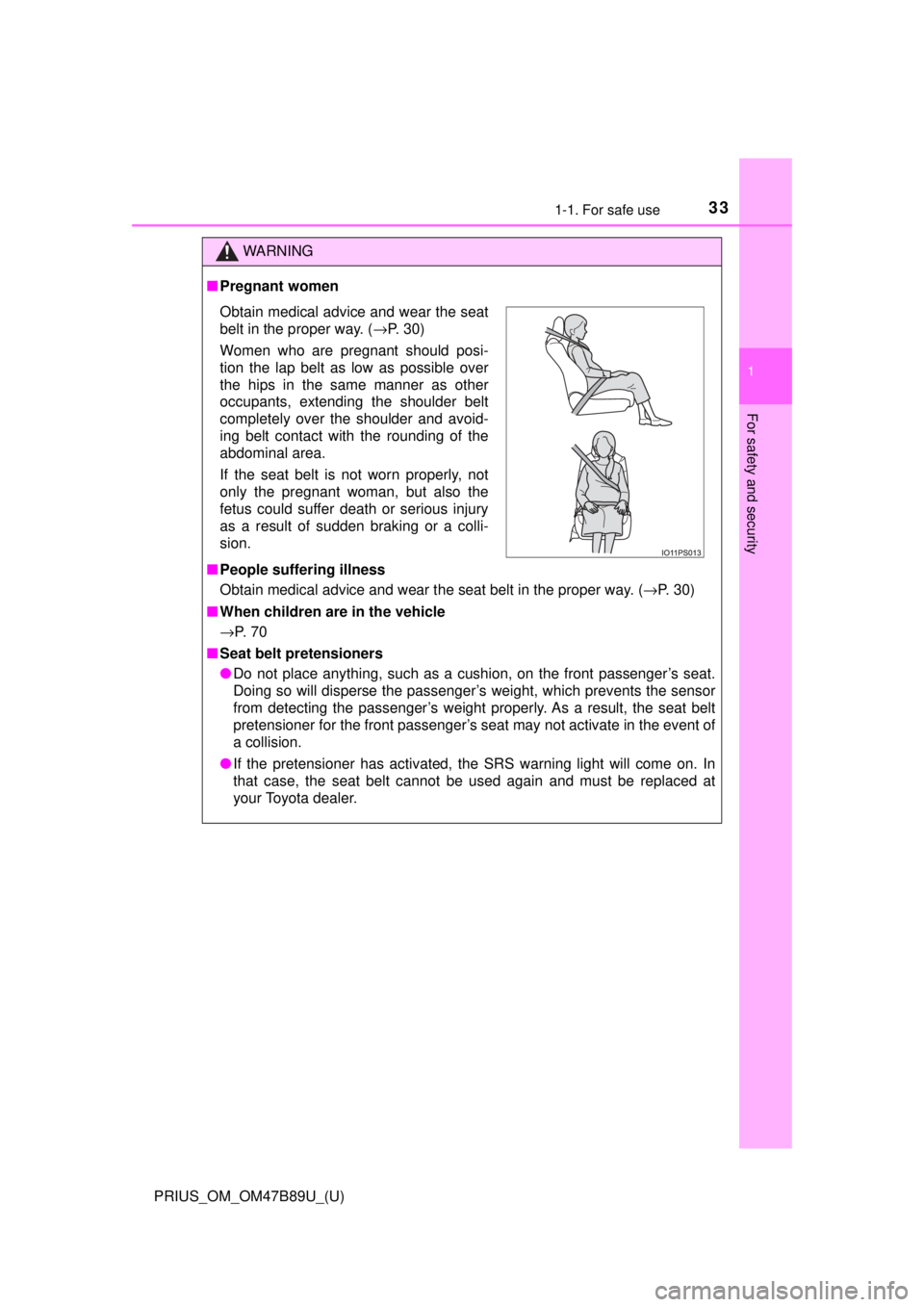
331-1. For safe use
PRIUS_OM_OM47B89U_(U)
1
For safety and security
WARNING
■Pregnant women
■ People suffering illness
Obtain medical advice and wear the seat belt in the proper way. ( →P. 30)
■ When children are in the vehicle
→ P. 7 0
■ Seat belt pretensioners
● Do not place anything, such as a cushion, on the front passenger’s seat.
Doing so will disperse the passenger’s weight, which prevents the sensor
from detecting the passenger’s weight properly. As a result, the seat belt
pretensioner for the front passenger’s seat may not activate in the event of
a collision.
● If the pretensioner has activated, the SRS warning light will come on. In
that case, the seat belt cannot be used again and must be replaced at
your Toyota dealer.
Obtain medical advice and wear the seat
belt in the proper way. ( →P. 30)
Women who are pregnant should posi-
tion the lap belt as low as possible over
the hips in the same manner as other
occupants, extending the shoulder belt
completely over the shoulder and avoid-
ing belt contact with the rounding of the
abdominal area.
If the seat belt is not worn properly, not
only the pregnant woman, but also the
fetus could suffer death or serious injury
as a result of sudden braking or a colli-
sion.
Page 38 of 820
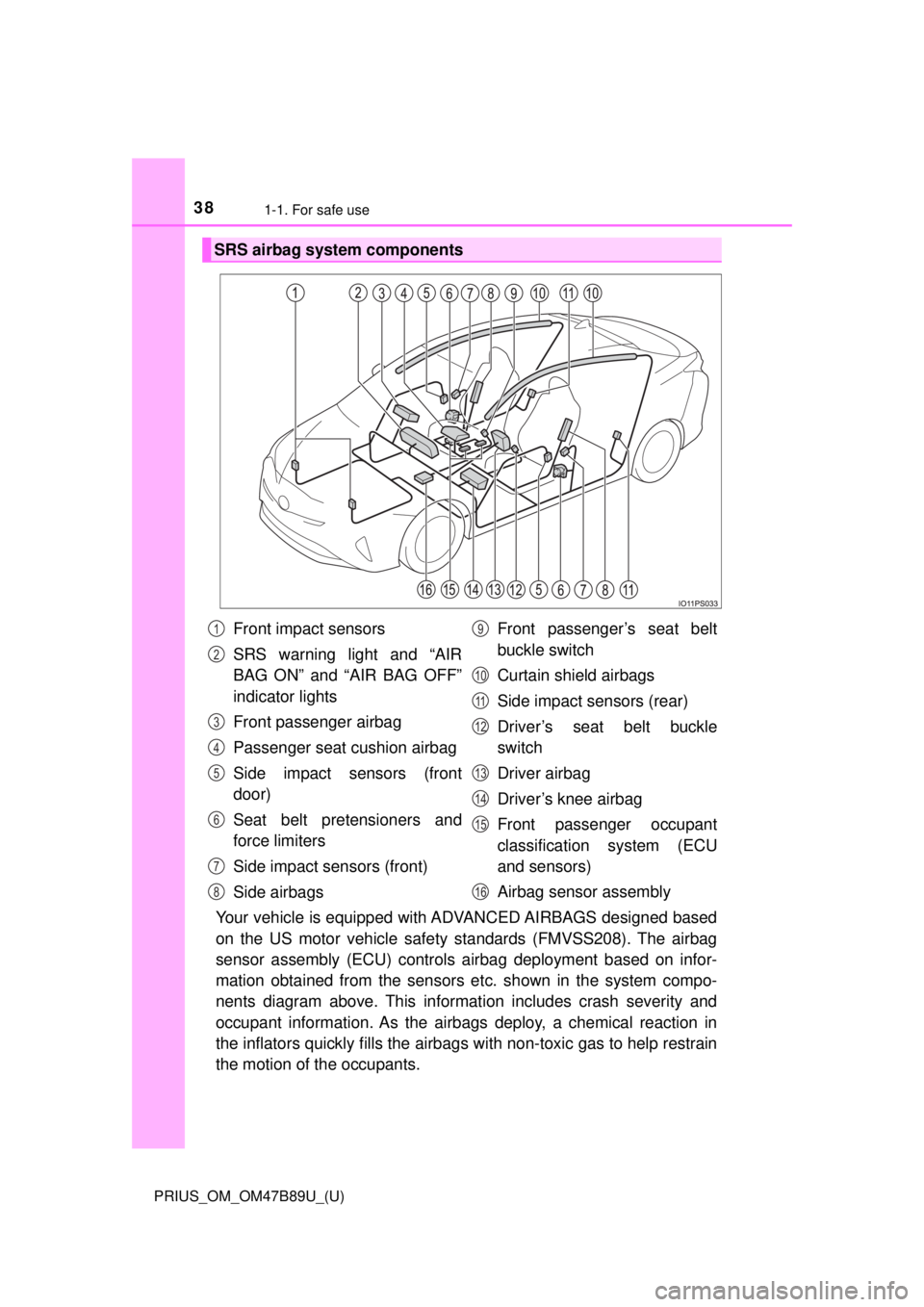
381-1. For safe use
PRIUS_OM_OM47B89U_(U)
Your vehicle is equipped with ADVANCED AIRBAGS designed based
on the US motor vehicle safety standards (FMVSS208). The airbag
sensor assembly (ECU ) controls airbag deployment based on infor-
mation obtained from the sensors et c. shown in the system compo-
nents diagram above. This informat ion includes crash severity and
occupant information. As the airbags deploy, a chemical reaction in
the inflators quickly fills the airbag s with non-toxic gas to help restrain
the motion of the occupants.
SRS airbag system components
Front impact sensors
SRS warning light and “AIR
BAG ON” and “AIR BAG OFF”
indicator lights
Front passenger airbag
Passenger seat cushion airbag
Side impact sensors (front
door)
Seat belt pretensioners and
force limiters
Side impact sensors (front)
Side airbags Front passenger’s seat belt
buckle switch
Curtain shield airbags
Side impact sensors (rear)
Driver’s seat belt buckle
switch
Driver airbag
Driver’s knee airbag
Front passenger occupant
classification system (ECU
and sensors)
Airbag sensor assembly1
2
3
4
5
6
7
8
9
10
11
12
13
14
15
16
Page 39 of 820

391-1. For safe use
PRIUS_OM_OM47B89U_(U)
1
For safety and security
WARNING
■SRS airbag precautions
Observe the following precautions regarding the SRS airbags.
Failure to do so may cause death or serious injury.
● The driver and all passengers in the vehicle must wear their seat belts
properly.
The SRS airbags are supplemental devices to be used with the seat belts.
● The SRS driver airbag deploys with considerable force, and can cause
death or serious injury especially if the driver is very close to the airbag.
The National Highway Traffic Safety Administration (NHTSA) advises:
Since the risk zone for the driver’s airbag is the first 2 - 3 in. (50 - 75 mm)
of inflation, placing yourself 10 in. (250 mm) from your driver airbag pro-
vides you with a clear margin of safety. This distance is measured from
the center of the steering wheel to your breastbone. If you sit less than 10
in. (250 mm) away now, you can change your driving position in several
ways:
• Move your seat to the rear as far as you can while still reaching the ped-
als comfortably.
• Slightly recline the back of the seat. Although vehicle designs vary, many drivers can achieve the 10 in. (250 mm) distance, even with the
driver seat all the way forward, simply by reclining the back of the seat
somewhat. If reclining the back of your seat makes it hard to see the
road, raise yourself by using a firm, non-slippery cushion, or raise the
seat if your vehicle has that feature.
• If your steering wheel is adjustable, tilt it downward. This points the air- bag toward your chest instead of your head and neck.
The seat should be adjusted as recommended by NHTSA above, while
still maintaining control of the foot pedals, steering wheel, and your v\
iew
of the instrument panel controls.
Page 44 of 820

441-1. For safe use
PRIUS_OM_OM47B89U_(U)
■If the SRS airbags deploy (inflate)
●Slight abrasions, burns, bruising etc., may be sustained from SRS airbags,
due to the extremely high speed deployment (inflation) by hot gases.
● A loud noise and white powder will be emitted.
● Parts of the airbag module (steering wheel hub, airbag cover and inflat\
or) as
well as the front seats, parts of the front and rear pillars, and roof side rails,
may be hot for several minutes. The airbag itself may also be hot.
● The windshield may crack.
● For Safety Connect subscribers, if the SRS airbags deploy or in the event of
a severe rear-end collision, the system is designed to send an emergency
call to the response center, notifying them of the vehicle’s location (without
needing to push the “SOS” button) and an agent will attempt to speak with
the occupants to ascertain the level of emergency and assistance required.
If the occupants are unable to communicate, the agent automatically treats
the call as an emergency and helps to dispatch the necessary emergency
services. ( →P. 574)
■ SRS airbag deployment conditions (SRS front airbags)
●The SRS front airbags will deploy in the event of an impact that exceeds the
set threshold level (the level of force corresponding to an approximately 12 -
18 mph [20 - 30 km/h] frontal collision with a fixed wall that does not move or
deform).
However, this threshold velocity will be considerably higher in the following
situations:
• If the vehicle strikes an object, such as a parked vehicle or sign pole,
which can move or deform on impact
• If the vehicle is involved in an underride collision, such as a collision in which the front of the vehicle “underrides”, or goes under, the bed of a
truck
● Depending on the type of collision, it is possible that only the seat belt pre-
tensioners will activate.
● The SRS front airbags for the front passenger will not activate if there is no
passenger sitting in the front passenger seat. However, the SRS front air-
bags for the front passenger may deploy if luggage is put in the seat, even if
the seat is unoccupied. ( →P. 50)
● The SRS seat cushion airbag on the front passenger seat will not operate if
the occupant is not wearing a seat belt.
Page 50 of 820
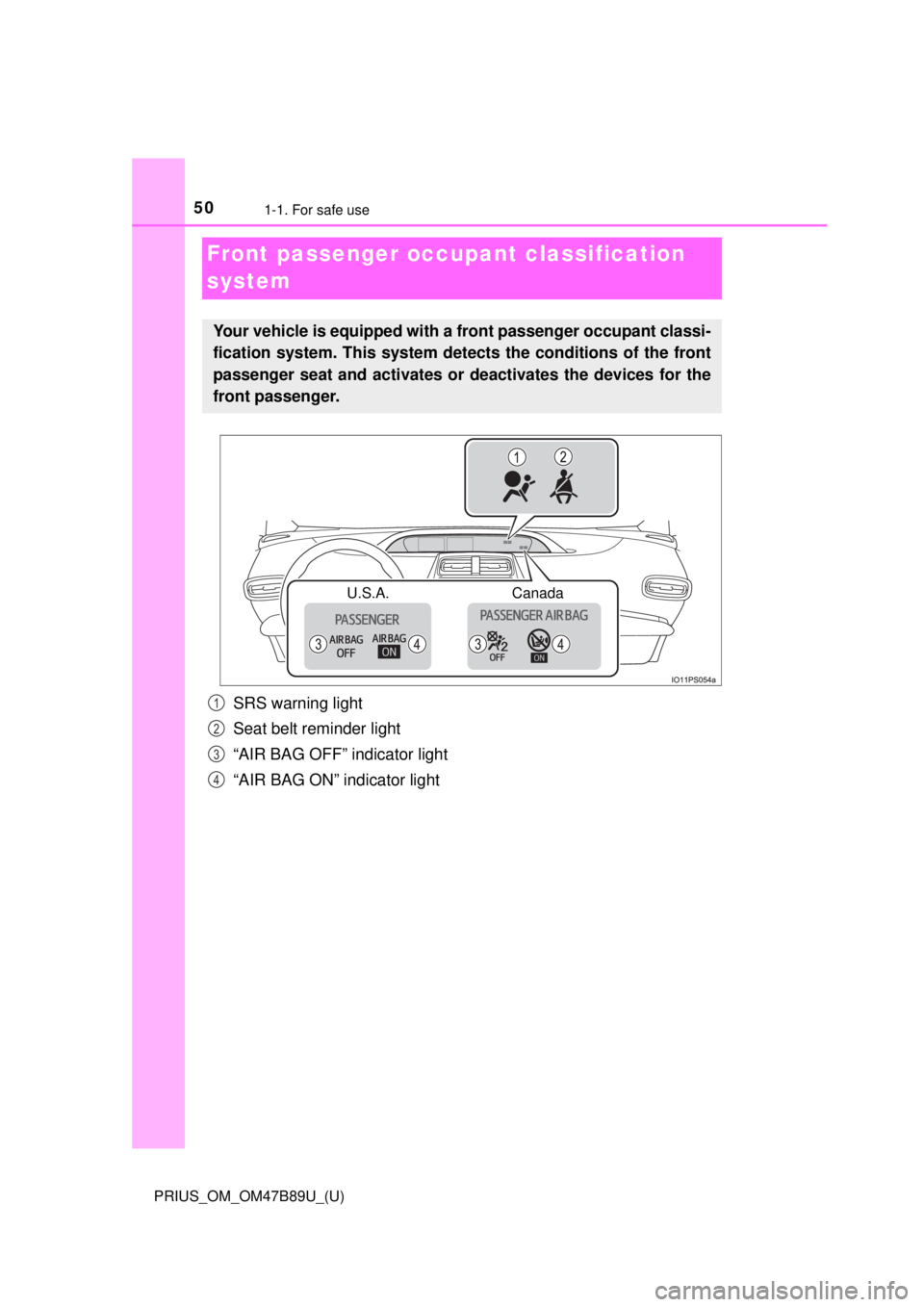
501-1. For safe use
PRIUS_OM_OM47B89U_(U)
Front passenger occupant classification
system
SRS warning light
Seat belt reminder light
“AIR BAG OFF” indicator light
“AIR BAG ON” indicator light
Your vehicle is equipped with a front passenger occupant classi-
fication system. This system detects the conditions of the front
passenger seat and activates or deactivates the devices for the
front passenger.
U.S.A. Canada
1
2
3
4
Page 51 of 820
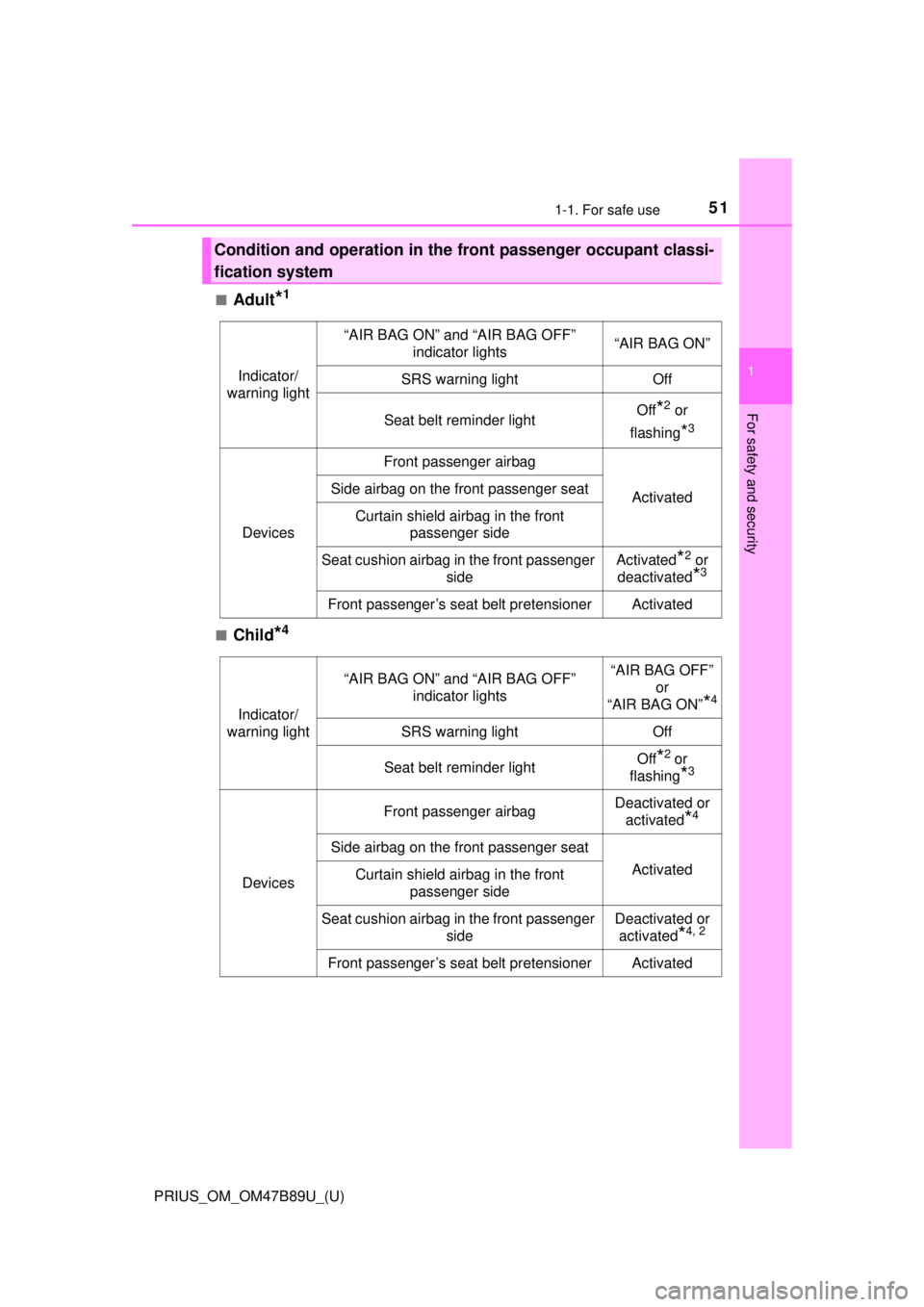
511-1. For safe use
PRIUS_OM_OM47B89U_(U)
1
For safety and security
■Adult*1
■Child*4
Condition and operation in the front passenger occupant classi-
fication system
Indicator/
warning light
“AIR BAG ON” and “AIR BAG OFF” indicator lights“AIR BAG ON”
SRS warning lightOff
Seat belt reminder lightOff*2 or
flashing
*3
Devices
Front passenger airbag
ActivatedSide airbag on the front passenger seat
Curtain shield airbag in the front passenger side
Seat cushion airbag in the front passenger sideActivated*2 or
deactivated
*3
Front passenger’s seat belt pretensionerActivated
Indicator/
warning light
“AIR BAG ON” and “AIR BAG OFF” indicator lights“AIR BAG OFF”
or
“AIR BAG ON”
*4
SRS warning lightOff
Seat belt reminder lightOff*2 or
flashing
*3
Devices
Front passenger airbagDeactivated or activated
*4
Side airbag on the front passenger seat
ActivatedCurtain shield airbag in the front passenger side
Seat cushion airbag in the front passenger sideDeactivated or activated
*4, 2
Front passenger’s seat belt pretensionerActivated